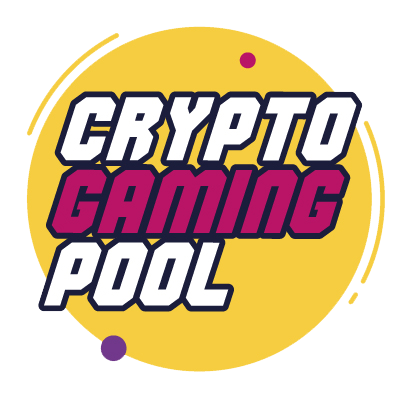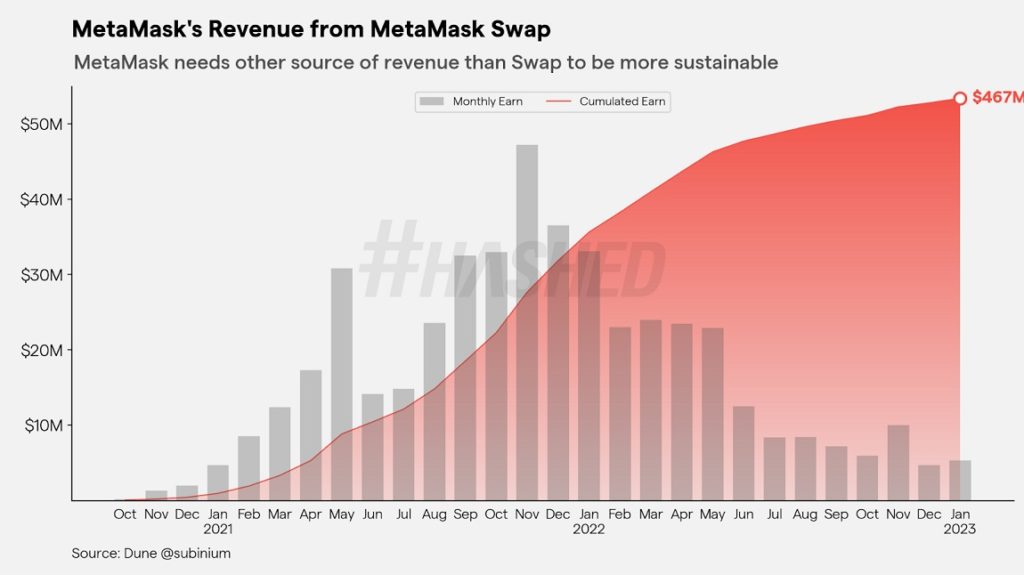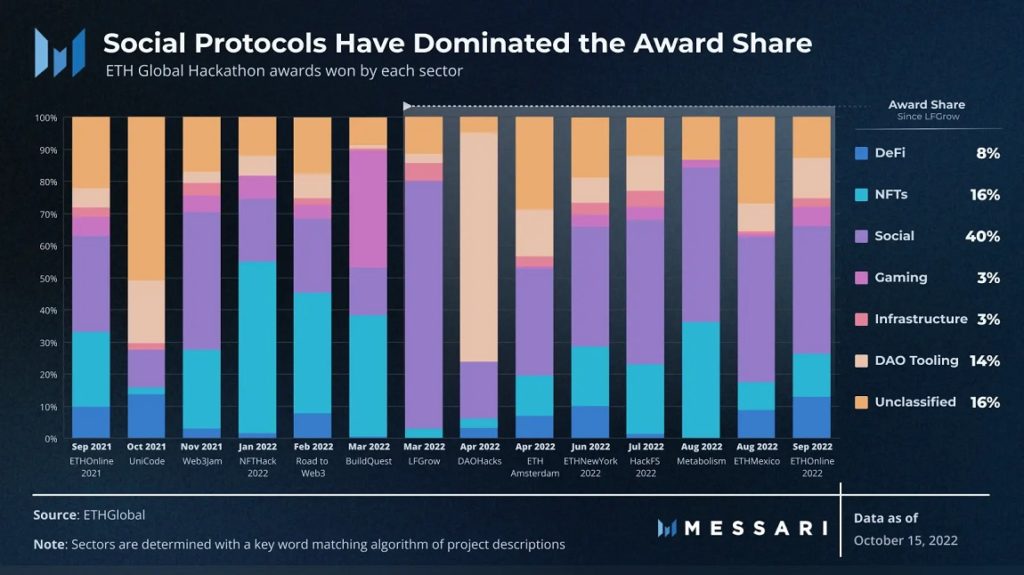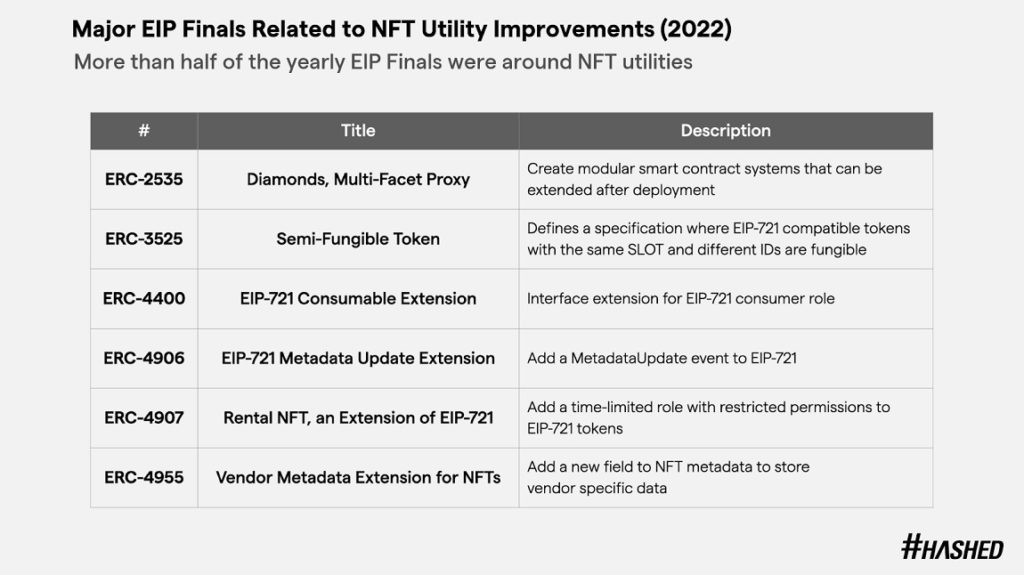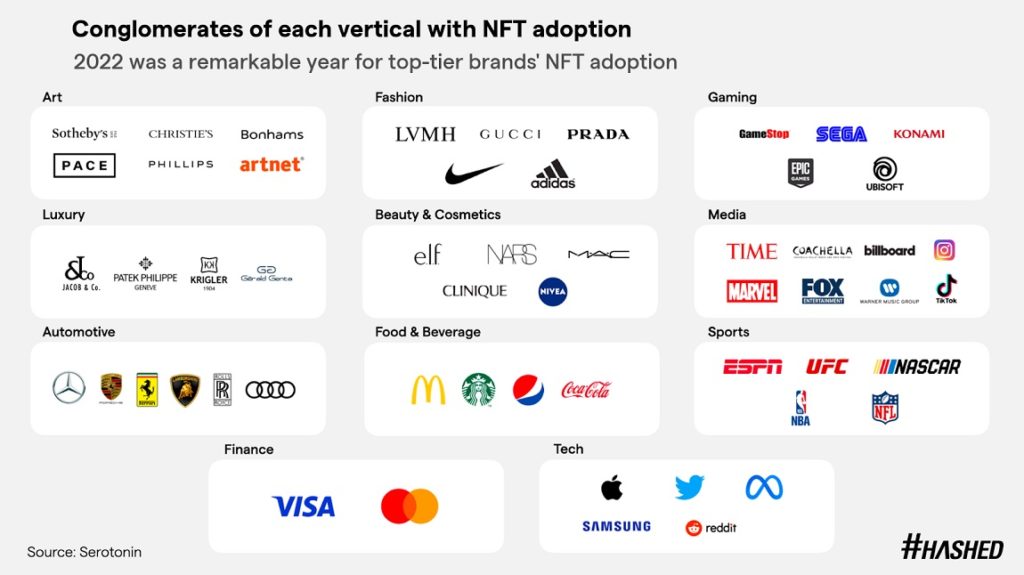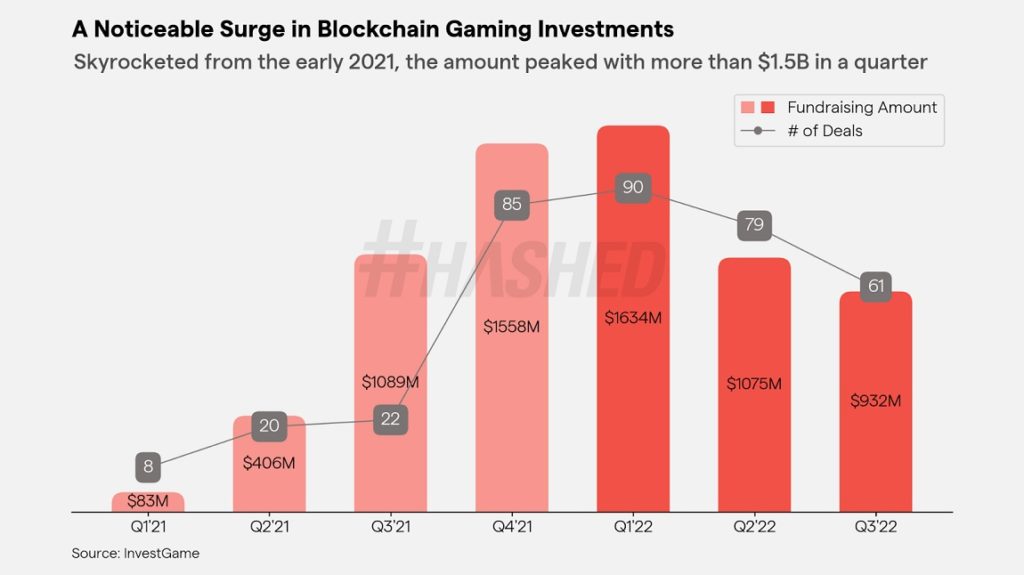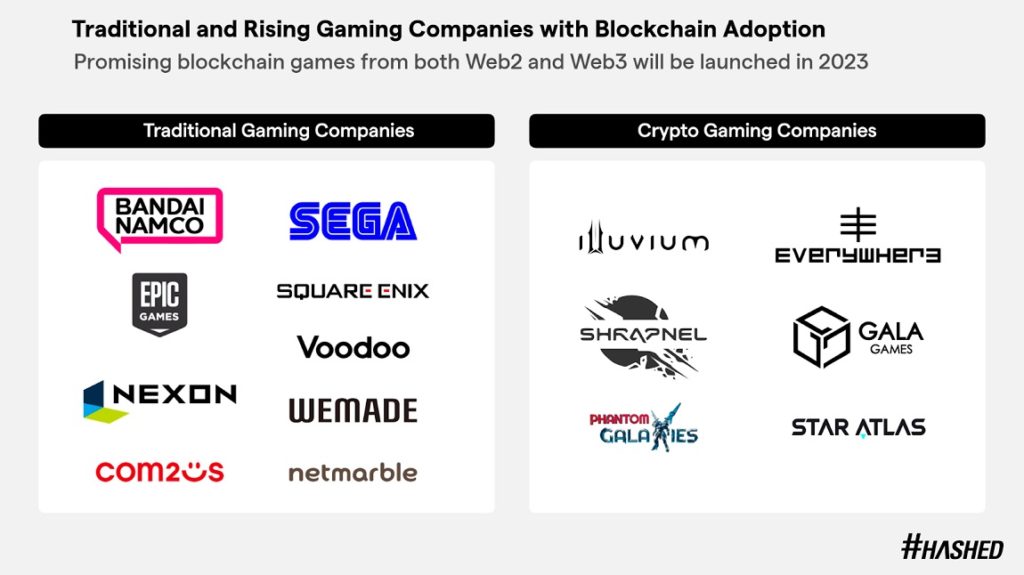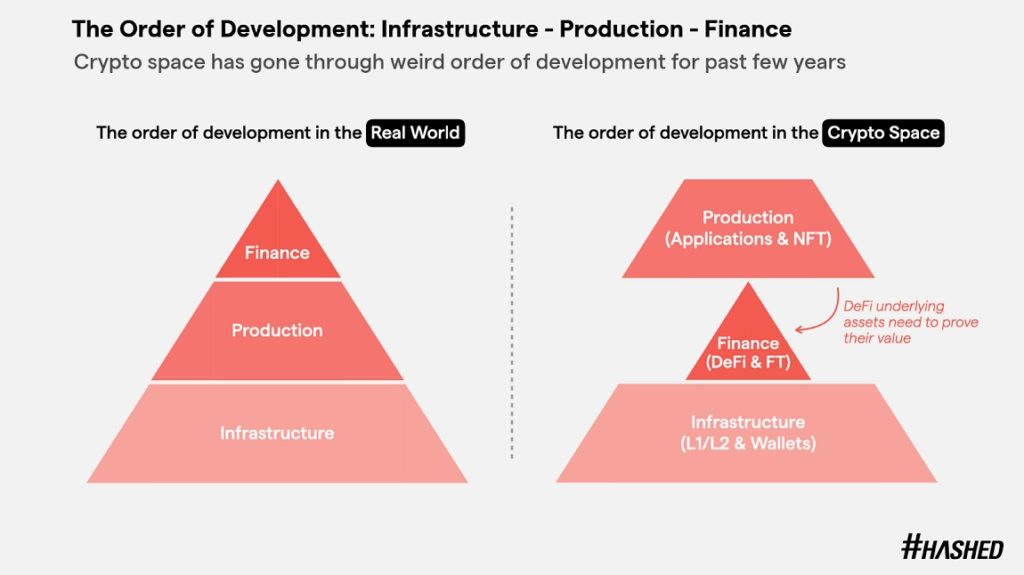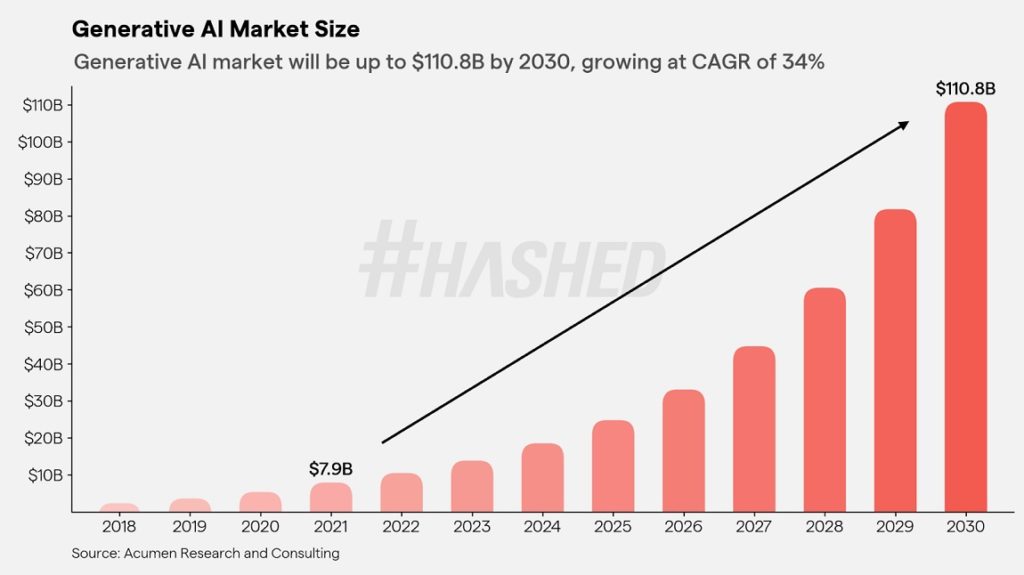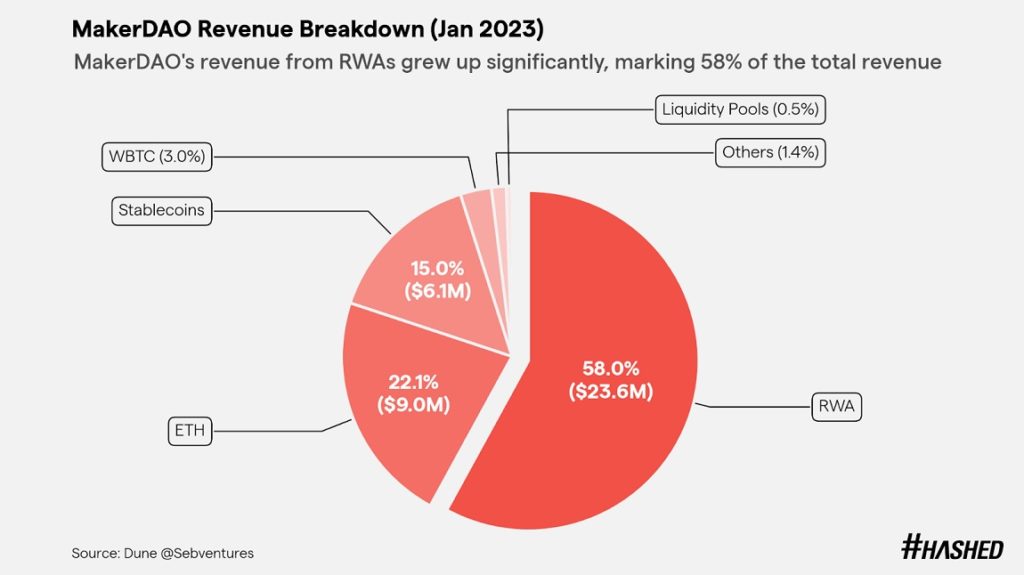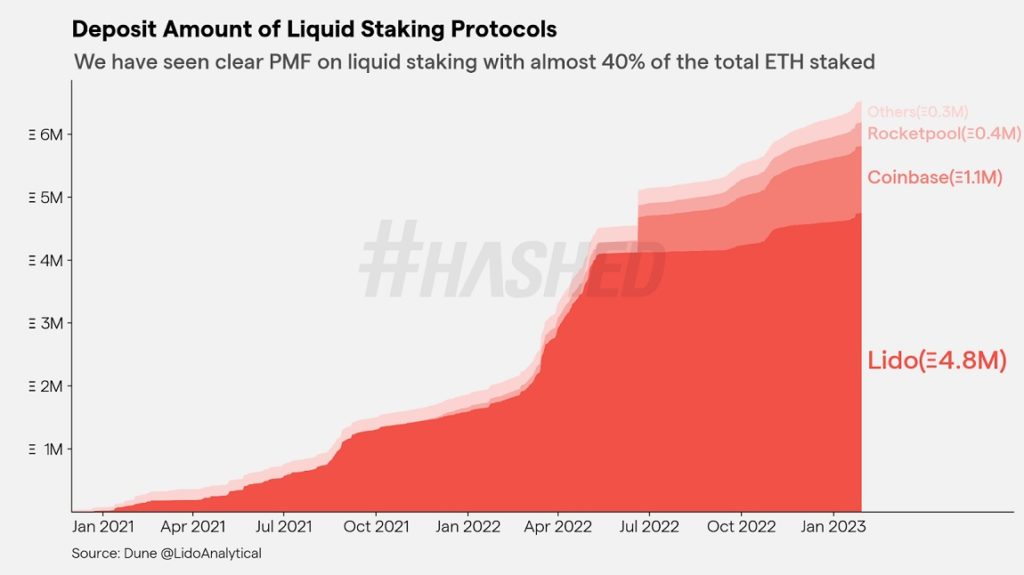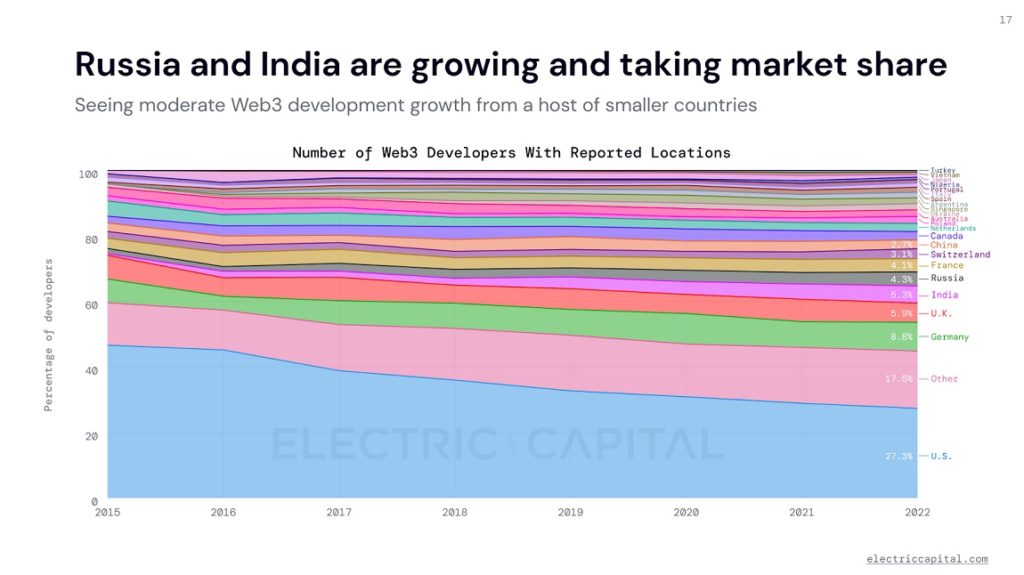Top 10 web3 trends for 2023 by Hashed.
Join our Telegram channel and chat to keep abreast of the main crypto gaming trends.
1. A breakthrough in the UX of wallets is expected to drive wider adoption.
As the crypto industry expands and its infrastructure improves, UX and security become more important to users. In this regard, wallet providers play a critical role in facilitating access to decentralized applications (dApps) and will bring together thousands of millions of new users. Problems still exist, of course, especially in terms of the complexity of managing private keys and signing protocols for the average user. Wallet promotion is not a new idea at all, but at the moment practical solutions support this thesis.
Solutions that address the complex issues of wallet key management and signature authentication for general users are gaining popularity. One such solution is Web3Auth, which uses Multi-Party Computation (MPC) technology to provide non-custodial logins, eliminating the need for seed phrases. other platform, Magic, offers wallet and SDK options for developers, allowing dApp login via email and SMS, completely bypassing the use of seed phrases. Besides, ramps also aims to provide those unfamiliar with cryptocurrencies with access to blockchain applications through easy social media login and single sign-on (SSO) through its mobile SDK.
With the exponential growth in mobile usage, wallet companies must prioritize mobile services to reach a wider audience. Coin98, a fast growing platform with a user base in 6 million people, has set its sights on becoming the leading mobile super app, focusing on improving the security of mobile transactions and improving the user experience. On the other side, Robinhood solves persistent problems like clunky design and excessive fees by launching standalone wallet app, which allows users to easily manage their assets while easily integrating with various dApps.
Smart contract wallets are also becoming another solution. They can be programmed with features such as spending limits, automatic transactions, and increased security through multi-signature capabilities. These wallets are intended for a wide range of users with different needs and levels of understanding, such as Silver, which offers social recovery and limit order features, and Safe, which is a non-custodial wallet that allows users to securely store and manage their digital assets through a multi-sig feature.
Moreover, the smart contract wallet space in the Ethereum ecosystem is also undergoing promising fundamental changes with account abstraction (AA), which aims to combine two types of Ethereum accounts: externally owned accounts (EOA) and contract accounts (CA). AA will eliminate the need for private keys for EOA and allow accounts to act like smart contracts, opening up potential use cases for improved key management and multi-signature capabilities. Visa recently demonstrated the potential of AA by developing automatic payment solution on StarkNet. And as interest in AA grows, we foresee that NEAR Protocol attract the attention of builders account model, which has already implemented multiple key pairs as a secret key.
Dappradar is a recognized leader in the field of cryptocurrency wallets and participates in the competition through MetaMask Flask. Flask allows developers to customize their own version of the MetaMask wallet. MetaMask Snaps, the very first feature of Flask, allows anyone to extend the power of MetaMask and open up new possibilities for its use with various blockchain protocols. They now rely on swaps for most of their sales and have a monotonous income stream. This revenue model generated over $450 million within 2 years of launch, but is very sensitive to market fluctuations.
In summary, the coming year is expected to see a rise in dApp integration with more secure login services with an intuitive UX. The focus will also be on the development of a mobile login offering a seamless user experience. In addition, the emergence of smart contract wallets could lead to a paradigm shift in the industry due to their ability to enforce software restrictions and automate transactions. The idea that wallets could be the next unicorn sector is not new, but given the expected influx of users thanks to practical technical advances, it is a promising prospect.
2. Web3 elements added to digital identity will take a step towards a decentralized social network.
The current digital identity system has several areas that need improvement. One of the main problems is fragmentation, where people have multiple identities across different platforms, resulting in a lack of accuracy and consistency in personal identification. Privacy and security are also a concern, as people are often required to provide sensitive information to establish digital identities across platforms, which can lead to identity fraud and financial crime if that information is used or shared without consent. In addition, centralized control by platform service providers is a concern. A digital identity is often controlled by a small number of companies or organizations, which can lead to a lack of control over one's own identity.
Blockchain technology can offer differentiated solutions to these problems by using private wallets and allowing people to verify their digital identity by demonstrating ownership of certain tokens or NFTs. Storing assets and information on the blockchain increases the accuracy and reliability of digital identity. Blockchain-based identity allows people to combine multiple online identities into a single, sovereign entity, giving them control and autonomy over their digital identity. Cyber Connect is an example of a company building a decentralized social graph protocol to provide users with composable self-identities using Web3 state tokens (W3ST) and CyberConnect profiles (ccProfiles).
Digital identities can also be created and managed without the use of tokens or NFTs, such as with DID (Decentralized Identifier) and VC (Verified Credentials), which are used by several Ethereum-based projects such as Disc и Orange Protocol, as additional tools for Soulbound Token. (SBT). It is important to note that one solution may not be enough for all privacy needs, and a combination of networked solutions such as SBT and standalone solutions such as VC may be required for optimal security and privacy. In addition, progress should be made in the development of better data storage solutions with privacy and partial decentralization, as well as seamless integration between different levels of identity.
Indeed, Web3 digital identity will unlock the full potential of decentralized social platforms. With a Web3 identity, users will be able to easily find, connect, and even have a closed community with others who share similar interests, such as using the same DeFi protocols, owning NFTs, or playing blockchain games. This new form of identity can also be integrated with existing identity systems, creating a seamless and interoperable digital identity that opens up a range of business opportunities.
The decentralized social network has been a growing trend throughout the year at hackathons, and 40% of awarded projects fall into this category. Lens Protocol has more than 60 projects created exclusively as a result of hackathons with various attempts to circumvent their social graph. Farcaster и Deso accordingly raised significant funds against the backdrop of this strong interest. This year, we can expect the initial development of blockchain-based social applications that take advantage of network effects through the use of a shared social graph.
3. Important experiments will be conducted to optimize the use of ZKP for privacy on account-based smart contract platforms.
Currently application zero knowledge proof (ZKP) in the crypto space is mainly focused on improving scalability through verifiable off-grid computing. Optimistic Rollup (ORU) scalability solutions such as Arbitrum and Optimism have gained popularity since launching their mainnets over the past two years. And since we entered 2023, ZK unification projects such as zkSync, scroll, Polygon zkEVM etc. are already in the testnet phase and we expect to see further optimizations and improvements in 2023. Overall, it looks like we are on the right track. Track the resolution of scalability issues in the crypto space.
As scalable solutions continue to evolve and support more advanced user interfaces, it becomes increasingly important for crypto to differentiate itself and gain a competitive advantage over traditional Web2 platforms. This shows the importance of privacy, which is another important application of the ZKP. Empowering services with privacy is critical to further improving the value proposition of crypto, as general user experiences such as voting, governance, payments, etc. can greatly benefit from the added privacy option.
Enforcing privacy on account-based smart contract platforms such as Ethereum is challenging due to the difficulty of encrypting registry state while keeping it validated. Several well-known teams are working on a solution to this problem using different approaches. One common approach among these protocols is incorporating "notes" from the UTXO model into an account-based system, to make ownership and transfer more explicit.
There are several notable examples of projects working on this problem. Aztec Connect SDK allows integration of Ethereum protocols with private rollup Aztec, which uses the encrypted UTXO architecture for privacy. ZK Money, based on Aztec Connect, already offers a private DeFi yield aggregator integrated with big projects like AAVE, Uniswap, etc. In addition, Polygon Midden is «hybrid UTXO and account-based state model" for EVM. compatible ZK rollups to support private transactions when they consist of offline data execution locally.
To facilitate experimentation and innovation with privacy-enhancing technologies, it is important to minimize friction for developers using these frameworks. Web3 Development already introduces a number of unfamiliar difficulties, such as fragmented indexing, additional security issues, and so on, so the complexity of adding privacy should be abstracted away as much as possible. There is no doubt that such efforts will further intensify in 2023 to create a healthy testing ground for interesting applications.
4. The programmable NFT technology introduced by Dynamic NFT will expand.
Over the past few years, the NFT landscape has undergone seismic changes, especially in the form of Profile Pictures (PFPs). However, image-based NFT trading volume dropped noticeably in the second half of 2022 as users began to crave more features. As a result, the NFT ecosystem is undergoing a transformation in response to this changing demand. Ethereum Improvement Proposals (EIPs) have served as an indication of the direction the Ethereum community is heading, with most of the recent proposals focusing on NFT standards, indicating the community's desire to use NFTs with added utility. We believe that 2023 will be the cornerstone when various NFTs, including Dynamic NFTs, will solve these problems by offering new features.
Dynamic NFTs are a unique type of NFTs that can adapt and evolve based on certain triggers in their smart contracts. These triggers can be the result of on-line or off-line events, or even actual events. Changes to the characteristics of a Dynamic NFT are usually made by changing its metadata. This process uses decentralized oracles to update metadata with off-chain events.
Dynamic NFTs can take many forms, for example, the functionality of the NFT can change depending on the athlete's performance statistics, or its appearance can change depending on weather conditions. Along with dynamic NFTs, there is a growing discussion in the community about other programmable NFTs that have advanced capabilities such as executable NFTs, NFT with split permissions and co-ownership. This opens up a variety of interactivity and interaction opportunities for creators, collectors, and gamers.
Programmable NFTs are expected to gain significant popularity in the blockchain ecosystem due to their ability to create advanced use cases that go beyond the traditional representation of digital property through images or records. These NFTs offer a wide range of possibilities, such as the ability to create interactive experiences, present unique and complex digital assets, and develop new financial instruments.
Meanwhile, the widespread introduction of dynamic NFTs requires solving the problem of the reliability of trigger events that cause these NFTs to change. This requires the implementation of more robust oracles and the establishment of clear NFT standards for trigger event authentication, as well as transparency and fairness in the smart contract rules governing these dynamic NFTs.
As the blockchain ecosystem continues to attract more and more game developers, artists, and entrepreneurs, the quality of their creations is also on the rise. The advent of Dynamic NFT is expected to add a new level of excitement to the NFT ecosystem in 2023. The abundance of talented creators in space will open up endless possibilities for new and creative use cases.
5. A variety of NFT utilities will be explored, and small and medium brands and creators will drive a new wave of adoption.
Despite an extended bear market and subsequent drop in sales, NFTs are becoming an increasingly popular way for companies to connect with customers. Large corporations such as Coca-Cola, Twitter и Visastarted using NFTs as a way to improve their brand image.
Disney, the epitome of unbreakable IP addresses revered by audiences of all ages and nationalities, recently delivered on its NFT promise. Disney's successful track record in creating derivative works such as films, games and other forms of media and entertainment, with its permanent intellectual property rights, makes this area a promising area for the company's expansion. As a demonstration of its commitment, Disney launched NFT-based digital collectibles along with Marvel, one of its subsidiaries. To support these efforts, they are actively looking for professionals with knowledge and experience in this area.
Regardless of the predictable mainstream success of NFTs, the benefits derived from owning NFTs often have no emotional value to the holder and are not permanent. In layman's terms, after acquiring an NFT, the owner may not feel a strong connection to it over time and may not know what to expect from owning it. While many NFT projects or studios provide occasional benefits as outlined in their roadmaps, they often fail to deliver the sense of ownership and true ownership of the underlying IP and content, such as the sense of community and exclusivity offered YugaLabs'Bored Ape Yacht. Club.
To overcome these hurdles, several and a growing number of teams are working to demonstrate how NFTs can provide genuine, ongoing utility and a sense of belonging/belonging to the community of holders. For example, Modhouse revolutionizes the K-pop entertainment industry by allowing fans to actively participate at a higher level and offering ownership through governance and voting based on NFT. To be more specific, Triple S is a one-of-a-kind K-Pop group that uses blockchain technology to give fans more influence on important decisions such as choosing a title song, selecting TripleS subgroups, and assigning individual members to each subgroup.
In 2023, small and medium brands, as well as individual creators, are predicted to use NFTs as a means to increase and maintain customer loyalty, echoing the example of large enterprises taken last year. This includes incorporating NFTs into membership and loyalty programs in real communities such as local restaurants and community events. It is expected that the practical benefits of NFTs, such as exclusive privileges at offline events, will drive the widespread adoption of NFTs.
Ensuring greater adoption of NFTs requires lowering barriers to entry for users through easy-to-use wallet services; For example, reddit repository allows users to easily access collectible avatars. At the same time, tools that enable non-crypto savvy people to use Web3 stacks effectively are just as important. Growing demand from brands and commerce for enhanced user experience in NFT communities will drive the use of services such as Rare Circles or CIETY, which allow you to run these communities without the need for coding or technical knowledge. OpenSea, the leading NFT marketplace, also recently launched "Drops, a tool for creators to launch their NFT projects. It also introduced customizable landing pages on EVM networks aimed at improving the experience for small and medium brands and creators. We expect such tools to drive further use cases and adoptions.
6. Blockchain gaming will have a resurgence with the introduction of trusted IPs and slick onboarding.
Blockchain games such as Axie Infinity, The Sandbox и Blank block party, showed unprecedented growth at the end of 2021, despite having only been launched within the last 2 years. Moreover, the emerging gaming ecosystem of the SEA market, with the emergence of new ideas such as gaming guilds, has also made GameFi a sought-after sector for both cryptocurrency developers and traditional gaming conglomerates.
We could see an increase in the market capitalization of major blockchain gaming projects as part of the initial wave of blockchain gaming in 2021-2022, but fell short of the high projections due to macroeconomic conditions and market turbulence. However, starting in the fourth quarter of 2021, the blockchain gaming sector, including GameFi, is raising more than $5 billion annually, and we expect to see a huge number of attempts, including several AAA games that will be officially implemented in 2023.
In order to provide gamers with an innovative experience, we often see the use of well-known IP addresses such as popular webtoons and movies, or even the IP addresses of recognized gaming masterpieces integrated with blockchain technology. Korean conglomerates such as Nexon и Netmarble, as well as global companies such as SEGA, Bandai Namco and Square Enix are also making efforts to include their intellectual property in games. For example, launching user-generated content (UGC) platforms using long-loved characters and storylines such as Gundam Metaverseis now becoming prominent, and Nexon has also unveiled a blueprint for a creator-focused ecosystem incorporating blockchain through MapleStory Universe, its most famous IP source. In the future, more content companies will expand intellectual property using blockchain for games.
However, the massive adoption of blockchain games cannot be explained solely by the use of well-known IP addresses. While AAA games with known IP addresses effectively address the problem of inadequate gaming experience, the pressing issue of high entry barriers for regular users remains unresolved. Axie Infinity, one of the highly successful blockchain games that boasted over 2021 million monthly active users (MAUs) in 2, once ran into trouble attracting a wider audience due to the difficulty of creating a wallet and buying assets. In the future, entry barriers are expected to be reduced, allowing gamers to play blockchain games without a wallet, or with a much simpler wallet creation process.
In 2023, the upgraded onboarding tools are expected to be gradually developed to attract more players, and the blockchain infrastructure will offer convenient mobile SDKs to facilitate the launch of top-notch games. Multi-chain wallet services specialized in the gaming sector such as Sequence и Face Wallet , will work in tandem with numerous blockchain gaming companies to increase accessibility, in addition to infrastructure companies with similar efforts such as Immutable Passport, the recently announced Immutable. X. This collaboration will help create a smoother and more convenient experience for all gamers, making the entire journey more accessible and enjoyable.
7. Building a Resilient Infrastructure for the Next Generation of DeFi: The Rise of NFT-Based Virtual Goods.
Production and finance are closely linked in the real economy. Manufacturing activities are based on natural resources and infrastructure, and the financial industry capitalizes on the growth of these activities by providing loans and other financial instruments. For example, a farmer can set up a ranch and raise cattle (Production), banks and securities firms can use this by providing financing or placing it on exchanges (Finance) and helping the farmer expand his activities.
However, until 2022, there was no such balance in the crypto economy as infrastructure-level projects such as cryptocurrency exchanges and the money market collapsed (Finance), leading to financial market instability before projects with reliable utilities and strong communities flourished ( Production). The backbone of the crypto-economy, blockchain technology (infrastructure), was established, but more production-oriented projects were needed to support its growth.
Major DeFi tokens have interdependent values, where the value of one token depends on the use and value of other tokens in the DeFi ecosystem. This creates a fragile structure in which a drop in the value of a single token could affect the entire DeFi market. For example, DEX A tokens accumulate value through transaction fees that are traded on DEX B, generating transaction fees for each other. Decentralized lending platform C earns commission by mortgage of tokens from A and B, and tokens from C are traded on A and B… and so on. This recursively formed interdependence has repeatedly caused the value of the DeFi market to plummet in times of regulatory uncertainty or skepticism towards the industry as a whole.
The main challenge in the blockchain industry is to create a solid infrastructure to make it easy for the general public to use and infuse the commodity production market with real value. Fortunately, despite setbacks, the volume of blockchain transactions is steadily growing. Currently there are 5 leading L1 projects with more than 1 million transactions (Ethereum, Solana, BSC, Polygon, Avalanche) offering scalable and proprietary modular solutions, easy onboarding and digital identity solutions.
In addition, digital products are gradually accumulating, including non-fungible assets produced through the L1 block space. Ethereum, the largest smart contract platform in existence, is still generating large NFT transactions after last NFT summer with a total trading volume of over $35 billion. Despite lower activity in the NFT communities and a decline in OpenSea trading volume, NFT secondary trading remains high at over $780 million per month.
Ethereum is no longer the only ecosystem with thriving communities based on a scarcity of non-fungible goods. Polygon is attracting millions of Web2 users through the adoption of major enterprise NFT programs such as Starbucks Odyssey, and the skyrocketing popularity of collectible Reddit avatars. Solana is also maintaining a monthly secondary trading volume of nearly $150 million despite a more than 80% drop in TVL and an accelerated churn of DeFi users. In mid-2022 NFT Solana, like Y00ts, have successfully created a unique and distinct community from the Ethereum NFT community. And the number of UAWs (unique active wallets) for NFT Solana almost quadrupled during the bear market from August to October 2022.
There will be new types of virtual goods that will likely start with games on the blockchain and the metaverse. These sectors accounted for the most funds in the first quarter of 2022. In addition, the use of the aforementioned programmable NFTs to represent real assets in the virtual world will be discussed in more detail this year.
As infrastructure participants accumulate valuable virtual goods and the infrastructure stabilizes, the financial models that have evolved so far will begin to work within that particular infrastructure. Exchange primitives such as OpenSea и Blur, lending platforms such as NFTFi и BendDAO, as well as various experimental models, including derivative platforms, are constantly being developed, although there is no clear winner yet.
DeFi smart contracts can be quickly applied to other blockchains, but products such as NFTs and the communities built around them cannot be copied and pasted. This year, the growth of blockchain ecosystems will focus on creating a minimum production scale to support these financial primitives, rather than DeFi-limited infrastructure. Major blockchains will focus on building a robust ecosystem around NFT-based products that are difficult to replicate, such as NFT communities and blockchain games.
8. AI will play an important role in blockchain game development and beyond.
Since its inception, the field of artificial intelligence (AI) has undergone significant changes. It has evolved from early research in natural language processing (NLP) and problem solving in the 1950s to more recent developments in data synthesis and machine learning (ML). This has led to AI becoming widespread in various industries, including healthcare, finance, media, and transportation.
There is a growing expectation that AI will become widespread in 2023, and a prime example is the success of large language model (LLM) models such as Chat GPT. The blockchain gaming industry is poised to benefit greatly from the advances of AI, especially in terms of streamlining the traditional game development process and providing a new level of gaming experience – all thanks to generative AI.
Generative AI has been a growing field for over a decade, but until recently it was not advanced enough to mimic or even surpass human capabilities in image, language and speech recognition. In 2021, the market was valued at $8 billion and by 2028, it is projected to reach $63 billion. As avid investors in the field, we are excited to see how it will continue to shape and innovate the industry in the coming years.
AAA game developers spend a significant portion of their budget on content creation, making it a major bottleneck in the gaming industry today. Leading game studios take at least 3 years to complete production, and developers must anticipate consumer trends years in advance of a product launch. The development cycle becomes even more complex in crypto games, where the focus is on decentralizing gameplay development for players, but their preferences can change quickly and unpredictably.
Generative AI could be a powerful solution to this problem. By collecting user behavior data from a core group of community beta testers over multiple iterations of the game, developers can train models to create unique generated content tailored to specific demographics such as levels, characters, and items. Such content is generated procedurally, evolving in response to changes in user behavior in real time. This not only provides players with a varied and dynamic gameplay experience, but also helps developers reduce the need for manual content creation.
The main aspect of crypto games is to encourage users to create their own user-generated content (UGC) with in-game utility and/or monetization potential. Creation tools in games like Minecraft, are just the tip of the iceberg as the combination of blockchain and generative AI allows users to create and monetize assets. Users can create weapons, items, or collectible cards with unique attributes, rarity, and value, and once integrated with the blockchain, they can trade, buy, and sell their custom items on online marketplaces. This provides a more immersive gaming experience and opens up new opportunities for monetizing game assets. It also opens up opportunities for original asset designers to earn royalties on secondary deals.
Game developers are already using various AI technologies, but the introduction of generative AI models and the applications that run on them can lead to significant transformations. AI integration can not only improve the game development process, but also improve the overall gaming experience for players.
Apart from games, we are also excited to see the potential of AI in other crypto verticals. Predictive risk management is an area that is growing in popularity among trading teams where they train generative AI models to generate synthetic financial data to simulate various market conditions – prices, CEX/DEX trading volumes, order book depth, AMM liquidity, etc. .It helps traders understand how to identify and respond to potential risks in a variety of market conditions.
Auditing smart contracts based on AI solutions is another area we are following. Today's audit process is cumbersome, inefficient and expensive. We expect future AI models for audit to be trained using a large data set of existing smart contract code, as well as information about vulnerabilities, bugs, and attack patterns. After sufficient data processing and cleaning, the model should be able to automatically parse and validate new smart contract code inputs.
The most effective AI solutions are those that improve the data collection process, both in terms of quantity and quality of the information received. We envision a future that has incentive data markets. decentralized computing protocols such as Filecoin, dFinity and GPU distributed rendering protocols such as Render network, are leading examples of projects embodying a common theme. With the advent of distributed AI protocols, parts of the ecosystem can be tokenized using incentives in exchange for user participation and data sharing to further improve the AI model. This symbiotic relationship between users, AI and tokens has huge potential to revolutionize the industry.
9. Institutional level finance will be implemented through the blockchain infrastructure.
Institutional finance is projected to experience significant growth in scale in 2023, driven in part by increased use of tokenized real world assets (RWA: Underlying Asset Application) and advances in enterprise-level staking and unsecured lending.
The most successful application of Real-World Assets (RWA) today is in stablecoins, with market leaders such as USDT, USDC and BUSD among the top XNUMX tokens by market cap. Cryptocurrency organizations show clear RWA initiatives: MakerDAO invests 500 million dollars into US Treasuries and corporate bonds and diversifying into other types of RWAs such as real estate, invoices and commercial loans. RWAs now account for almost 60% of Maker's total protocol revenue, demonstrating the potential of this space.
Another major development in institutional finance is the rise in enterprise-level liquidity rates driven by the expansion of the LSD (liquid staking derivatives) sector. Companies such as Alluvialare developing enterprise-grade standards for liquid staking to link institutional capital and PoS blockchains. This allows token holders to stake their tokens and receive a token that can be used as collateral, which improves capital efficiency. The fairness of the requirement for staking liquidity was demonstrated by the expansion of the market, which increased from 21% to almost 40% of the total supply of tokens staked within one year.
Decentralized lending has grown rapidly over the past two years, but most current lending models require over-collateralized debt positions and online borrowers do not have access to general purpose loans. The DeFi space has become complex with a high learning curve and fragmentation of multiple dApps and infrastructure, making it difficult to manage positions and generate sustainable returns. The bear market has exposed the fragility of income farms, and the rise of unsecured P2P lending is seen as a more sustainable source of real returns. Online unsecured lending provides transparency, allowing underwriters to make proactive lending decisions. Projects such as maple finance и Goldfinch are actively working to provide capital to real institutional enterprises in a decentralized manner.
However, the DeFi space is not without problems. The lack of clear rules for cryptocurrencies is a major uncertainty for the industry, but if the industry can drive iterative progress in tokenization and securitization on the network in order to have well-defined guidelines, it could greatly benefit the sector and open up a wide range of opportunities. For real activities that bring cash flows.
Overall, we view institutional changes as an inevitable progress in DeFi as CeFi continues to consolidate. Traditional financial institutions are expected to experiment more with mature DeFi protocols such as MakerDAO. AAVE и Centrifugal. In addition, a surge of startups focused on integrating traditional financial institutions into the cryptocurrency market in accordance with regulatory requirements is expected. This blending of features has the potential to be a larger additional layer of funding, especially in emerging markets where millions of entrepreneurs do not have access to the financial system.
10. Emerging markets, led by India, are challenging US dominance in innovation and open source.
Cryptocurrency has seen a constant influx of new entrants, especially in high-growth markets such as India. According to Global Crypto Adoption Index 2022 published by Chainalysis in September last year, India is a leader in both centralized and decentralized transfer amounts, demonstrating a remarkable degree of crypto adoption among emerging economies. Meanwhile, the United States, which has long been the hub of global blockchain innovation in terms of vendors, is currently facing challenges due to the rapid technological advancement taking place in developing countries represented by India..
Over the past decade, India has emerged as a hub for technological innovation and is considered one of the world's leading sources of technical talent. Over 3500 engineering colleges, annually graduating more than 1,5 million engineerswill make India home to the world's largest software developer base, which will overtake the US by 2024. layer of transnational corporations. In addition, India is witnessing the fastest growth in the world in terms of open source contributions supported by the developer community from 9,7M on GitHubsecond only to the USA. Only in 2022 2,5 million people from India have joined GitHub. The growing presence of India in this space is a positive sign of the country's future contribution to technological progress.
The largest beneficiary of this skilled workforce has been the software-as-a-service industry. The Indian SaaS industry is predicted to will grow 25 times to $50–70 billion в over the next decade. The Indian Founders have launched several globally recognized SaaS products and developer tools including Freshworks, Zoho, Hasura, Postman, etc. With the right ecosystem support, India could also lead the next wave of innovation in the emerging world of blockchain. According to Electric Capital Developers Report 2022While the US continues to see a decline in Web3 developer market share, India has steadily increased its market share to over 5% in a relatively short period of time and is already in the top four countries in terms of the number of Web3 developers.
Indian SaaS has shown exponential growth and activity: more than 500 former employees of Indian SaaS companies became founders themselves. This trend has continued in blockchain infrastructure as several founders have split from Web3 organizations to start on their own. The first employees of leading Web3 projects from India, such as Polygon, continued to create blockchain infrastructure projects.
The evolution of SaaS and infrastructure in the blockchain space is likely to reflect the path of the Indian SaaS revolution, albeit at a much faster pace due to low cost, skilled and large English-speaking talent base, improved technology infrastructure, the software and modular nature of cryptocurrencies, and the trend towards digital GTM has accelerated due to COVID. The above factors are likely to place India at the center of the blockchain infrastructure movement, with founders creating products in both the horizontal and vertical domains. We are excited to see these key themes emerge given the short-term volatility but continued long-term growth of innovative Indian Web3 projects.
Subscribe to our telegram channel and go to our main chat to discuss the latest news.
